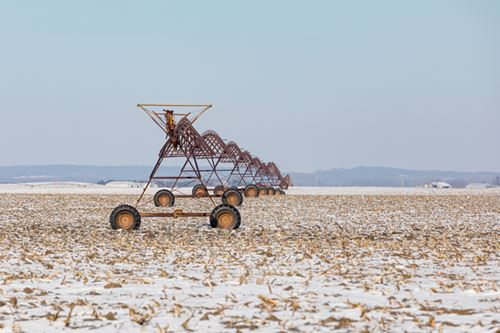
In most regions of the United States, days are getting shorter and colder as summer halts to a stop and fall/winter weather rolls in. By this point, many farmers are looking to hang up their hats and hibernate for winter. An important task to do prior to freezing temperatures is winterizing of irrigation systems. Winterizing is an important step in maintenance for the system and ensures that you’ll have ready-to-go irrigation pumps and equipment come next spring – saving you from downtime during the valuable growing season.
Winterization seems like it would be a straightforward task, however the steps on your checklist may change depending on what kind of irrigation system you have. We’ll be covering one of the most common types in the U.S., center pivot.
Center pivot irrigation utilizes a system of sprinklers that move on wheeled “towers” in a pretty much circular pattern, hence the name. Most used in the Midwest, center pivot irrigation is useful for large, flat areas of land.

Center Pivot Irrigation
When preparing a center pivot irrigation system for winter, there are several different “nooks and crannies” that need to be checked for proper winterization. To begin, when you are preparing to shut down your system for the year, conduct a sprinkler performance check. This includes using a “catch-can” uniformity test. This test uses any type of containers (typically cans are used, which is where the name comes from) that are set up at different intervals along the irrigation system. Then, the sprinklers are turned on in each zone for a few minutes and the water caught in the containers is measured. If the water levels are equal – or near equal – your system is working efficiently.
A couple of other winterizing checklist items:
-
Inspect the line for leaks, damaged pipes, and missing or malfunctioning sprinklers. It is advised to service any gearboxes, drive lines, and motors on pivot towers as well.
-
After the catch can performance test, it is important to drain the irrigation system. Remove any plug to drain the water, keeping in mind that any portion of the machinery can hold water. Don’t forget to check the pump casing, too.
- Double check your pivot wheel tracks and restore any ruts, deep wells, or holes.
- Drain and clean chemigation pumps and hoses.
For vertical turbine irrigation pump motors in particular, the following suggestions are recommended:
- Top off the motor’s oil level, filling it to the MAX line on the oil sight glass. This will help to prevent corrosion. Just remember to drain the oil completely before moving the motor for any reason.
- Any motor space heater should be connected to the pump’s control panel and powered on through the winter months. (Current examples of models that include space heaters already are our SINEWAVE OPTIMIZED® Motor and Inverter Duty VHS Motors (250 HP and below)).
As a last step, make sure that you secure your components – close any cover openings and lock any control boxes.
No matter what type of irrigation system you use, some other helpful overall tips include:
- Protect your investments: Store large equipment used in irrigation systems safely inside – or at least in a space that has cover from wind or precipitation. Ideally, a space that would keep any furry or insect pests from damaging your equipment as well
- Shut off Water Supplies, Timers, and any automated accessories: When your irrigation system is good to be shut down for the season – completely shut off the water supply to the system along with any other electronic timers or controllers. This makes sure that there is absolutely nothing running on your system that you don’t know about.
- Drain your pipes: Water expands when it turns to ice in freezing temperatures. Prevent cracks, bulges, and bust pipes in the winter by making sure your pipes have no water in them.
- Add Insulation: Particularly, add insulation around any above-ground pipes and valves – but take care not to cover air vents or drain outlets.
If you require any technical assistance with your motor – either with winterizing or getting it started in the new year, please contact us with any questions.

